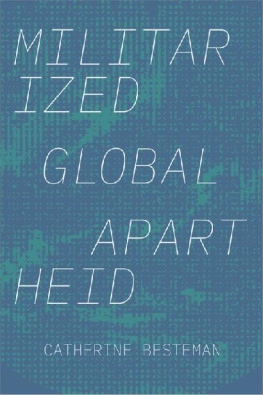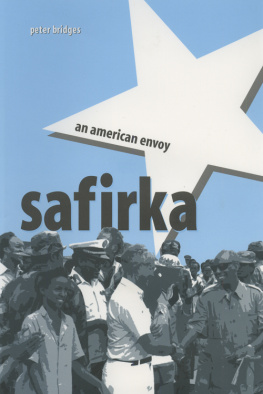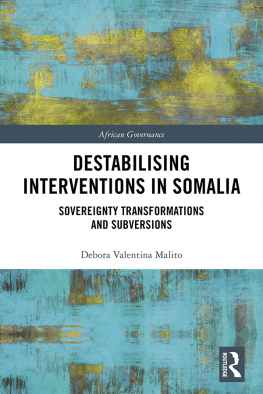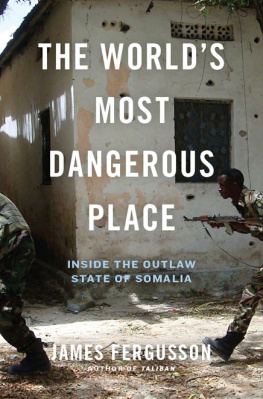Copyright 1999 University of Pennsylvania Press
All rights reserved
Printed in the United States of America on acid-free paper
10 9 8 7 6 5 4 3 2 1
Published by
University of Pennsylvania Press
Philadelphia, Pennsylvania 191044011
Library of Congress Cataloging-in-Publication Data
Besteman, Catherine Lowe.
Unraveling Somalia : race, violence, and the legacy of slavery / Catherine Besteman.
p. cm. (Ethnography of political violence)
Includes bibliographical references and index.
ISBN 0-8122-3488-X (alk. paper). ISBN 0-8122-1688-1 (pkb. : alk. paper)
1. Qossoldoor (Somalia)Politics and government19th century. 2. Qossoldoor (Somalia)Politics and government20th century. 3. Qossoldoor (Somalia)Ethnic relationsHistory19th century. 4. Qossoldoor (Somalia)Ethnic relationsHistory20th century. 5. Gosha (African people)SomaliaQossoldoor19th century. 6. Gosha (African people)SomaliaQossoldoorHistory20th century. 7. SlaverySomaliaQossoldoorHistory19th century. 8. SlaverySomaliaQossoldoorHistory20th century. I. Title. II. Series.
DT409.Q27B47 1999
967.73dc21
98-33372
CIP
Acknowledgments
Writing this book has shown me how much I still do not know about Somalia and the middle Jubba valley. Ive become uncomfortably aware of how many things I overlooked or ignored while in Somalia, of how many questions I forgot to ask or left unpursued, of how many issues I put off for a later time which never came. But for the things I did learn or come to understandand about which I can confidently writeI am indebted to a great number of people.
I must first thank the Land Tenure Center of the University of Wisconsin, who hired me to study the effects of land registration in Somalia. They paid for my year-long field research and generously continued my salary through the initial period of writing. I was very lucky indeed to be able to work for John Bruce and Michael Roth, whose support, encouragement, and high expectations set a standard for professional research.
I remain deeply indebted to my teachers and mentors at the University of Arizona. The late Robert McC. Netting provided a stellar model of professionalism, scholarly integrity, deep dedication, and good humor which will guide me the rest of my life. Ellen Basso, Dick Henderson, Helen Henderson, and Tad Park taught me the rigors of anthropological theory, research methodology, fieldwork pitfalls and successes, and the value of enduring friendships. Thanks also to Glenn Stone, who pointed me toward fieldwork in Somalia and dissertation support in New Mexico.
In Somalia, I was fortunate to enter a community of dedicated researchers and fieldworkers, who provided support, encouragement, and welcome mats in Mogadishu. Thanks to James and Nancy Merryman, Kathryn Craven, Gus and Marie Tillman, Ian Deshmuck, and Kenneth Menkhaus. I am enduringly grateful for the companionship and assistance my husband and I received from Annie Hellstrom and the Swedish Church Relief in the middle valley. Francesca Declich helped guide me through colonial archives in Italy. I have also benefited greatly from the scholarly activities and expectations of the international community of Somalist scholars. In particular, I have been much inspired by Lee Cassanellis prodigious and creative intellectual energies. He read the entire book manuscript, offered trenchant criticisms which forced me into rewrite after rewrite, and provided a model of enthusiasm for debate, critique, and learning. Several other colleagues read portions of this book and provided thoughtful, insightful criticism which encouraged me to rethink or better articulate significant points. In particular, I want to thank David Nugent, James Webb, Roger Sanjek, Ali Jimale Ahmed, Ken Menkhaus and an anonymous reviewer. Id also like to acknowledge how important a collegial department is for ones scholarship: I have been lucky to work in such departments at both Queens College (CUNY) and Colby College.
The farmers and herders of the middle Jubba valley who taught me about their lives and histories also gave their friendship, trust, endless patience, courage, and poetry. While I owe thanks to hundreds of mid-valley dwellers, I would particularly like to acknowledge Xassan Isaaq Towoqal and his family, Macallin Caddow Nasib, Sheikh Axmed Nur, Iido Rooble, Jimcale Matan Gosar, Cali Osman Iido, Adan Kabirow Boore, Xeffow Yusuf Cali, Binti Dhoore Baraki, Matan Garad Garas, Maxamed Muxumed Maxamed, and Hassan Ibrahim Diriye. I also thank Sheikh Biyoy, Haji Farxaan Abshir, Axmeey Cabdi Xaadle, and Deerow Xassan Dhogor. Cali Ibrahim Axmed, Cabdi Axmed, Maxamed Maxamed Raghe, and Sadiiq Cabdiraxmon Axmed worked tirelessly with me in Loc on all aspects of the research. I am profoundly grateful to them for their substantial contributions to this study.
The research for this book was funded by a variety of institutions, in addition to the Land Tenure Center: a Jacob Javits Fellowship supported my graduate work; the School of American Research supported my dissertation writing with a Weatherhead Fellowship; Sigma Xi, the American Philosophical Society, the National Endowment for the Humanities, PSC-CUNY Research Foundation, and Colby College supported archival and comparative bibliographic work; and Wenner-Gren provided sabbatical support with a Richard Carley Hunt Fellowship. I am extremely grateful to these institutions for their generous funding.
Funding is critical, but so is time to write. Id like to acknowledge the support I received from my department chair at Queens College, Frank Spencer. Colby Colleges policy of providing a pre-tenure sabbatical allowed me the time to finish the manuscript. Laurie Besteman and Jack Lauderbaugh provided a warm home for an extended family, companionship, good humor, and great wine for part of my sabbatical. Colby supported excellent summer research assistants who helped with library work: thanks to Karen Fried, Jill Kooyoomjian, Brian Schwegler, Andrew Rice, Pia Rice, and Jenny McElhinney. I am grateful to Suzanne Jones for her technical assistance. Many thanks also to the series editor, Cynthia Mahmood, and to Penns wonderful editor, Patricia Smith.
It is impossible to express my deep gratitude to my family: my husband and children, and my parents and siblings. My parents taught me a love of learning and inquisitiveness. My children still love books despite the amount of time their mother devoted to this one. My husband, Jorge Acero, shared the fieldwork, took the photographs which grace this book, and encouraged me through every stage of the research and writing; its completion owes as much to his patience and encouragement as to my efforts.
Chapter 1
Somalia from the Margins: An Alternative Approach
A letter arrives, telling me that every child under the age of five was now dead in the Jubba valley village in southern Somalia where I had lived several years previously. The collapse of the Somali state in 1991 ended these young lives in starvation and warfare, opening yet another violent chapter in the short history of the Jubba valley. In just the past 150 years, the people of this valleymost of whom were considered racial minorities within the Somali nation-statehad endured a series of violent encounters that shaped their relationship to the state and to regional Somali society. Such encountersincluding enslavement, forced labor on colonial plantations, periodic pastoralist raids, kidnapping by the state military, and forceful land dispossession in the biggest political landgrab in Somali historypresaged their vulnerability in the violence of civil war. When the Somali state collapsed, the people of the Jubba valley disproportionately faced genocidal assault, banditry, and widespread rape. Although the valleys population has been massively reduced through starvation, murder, and flight since 1991, the valley remains one of the most contested areas in the militia wars that continue to plague southern Somalia.










